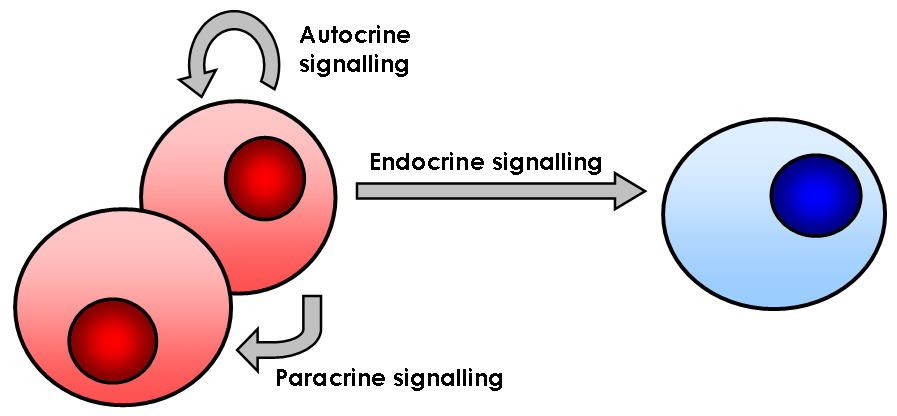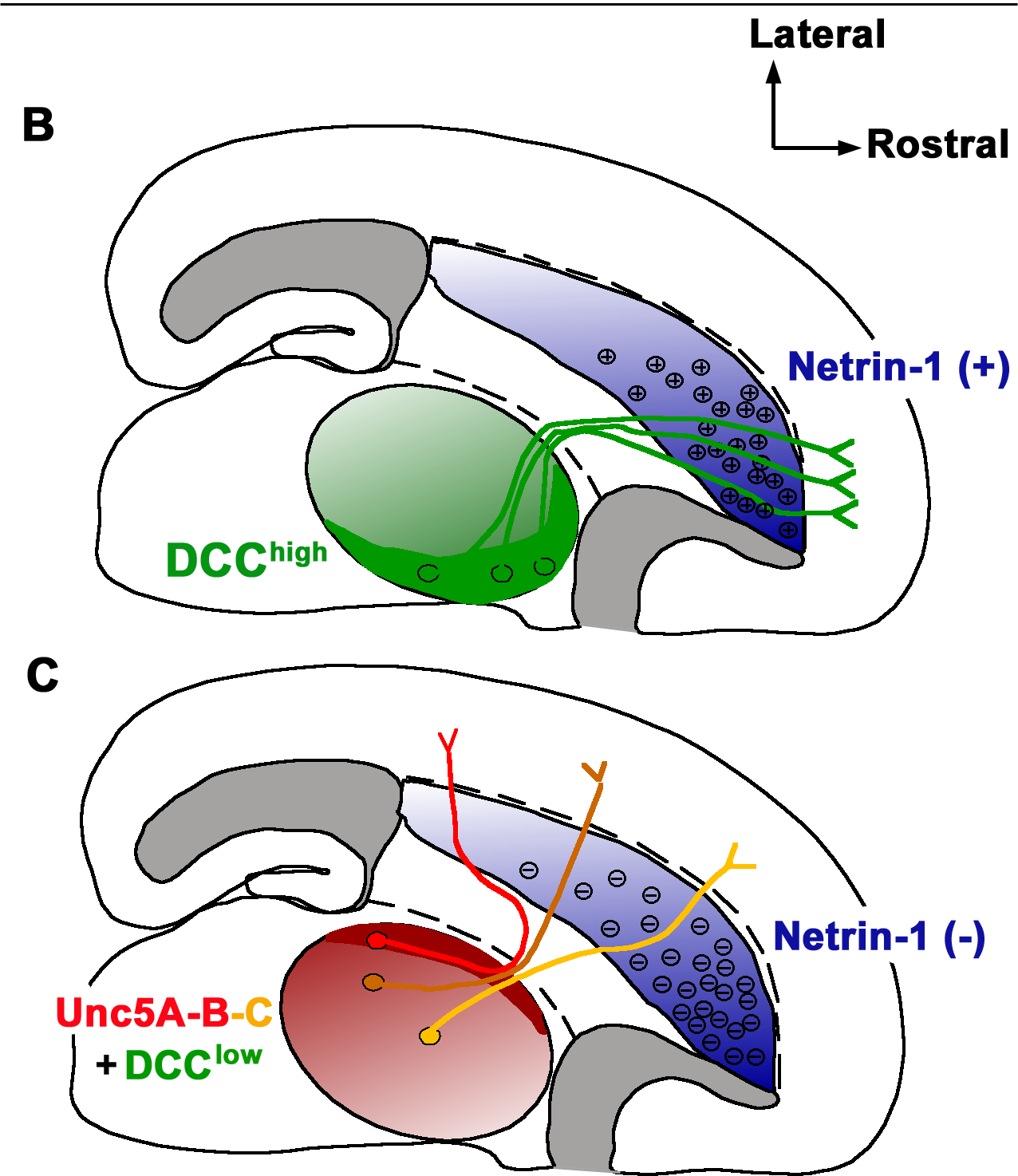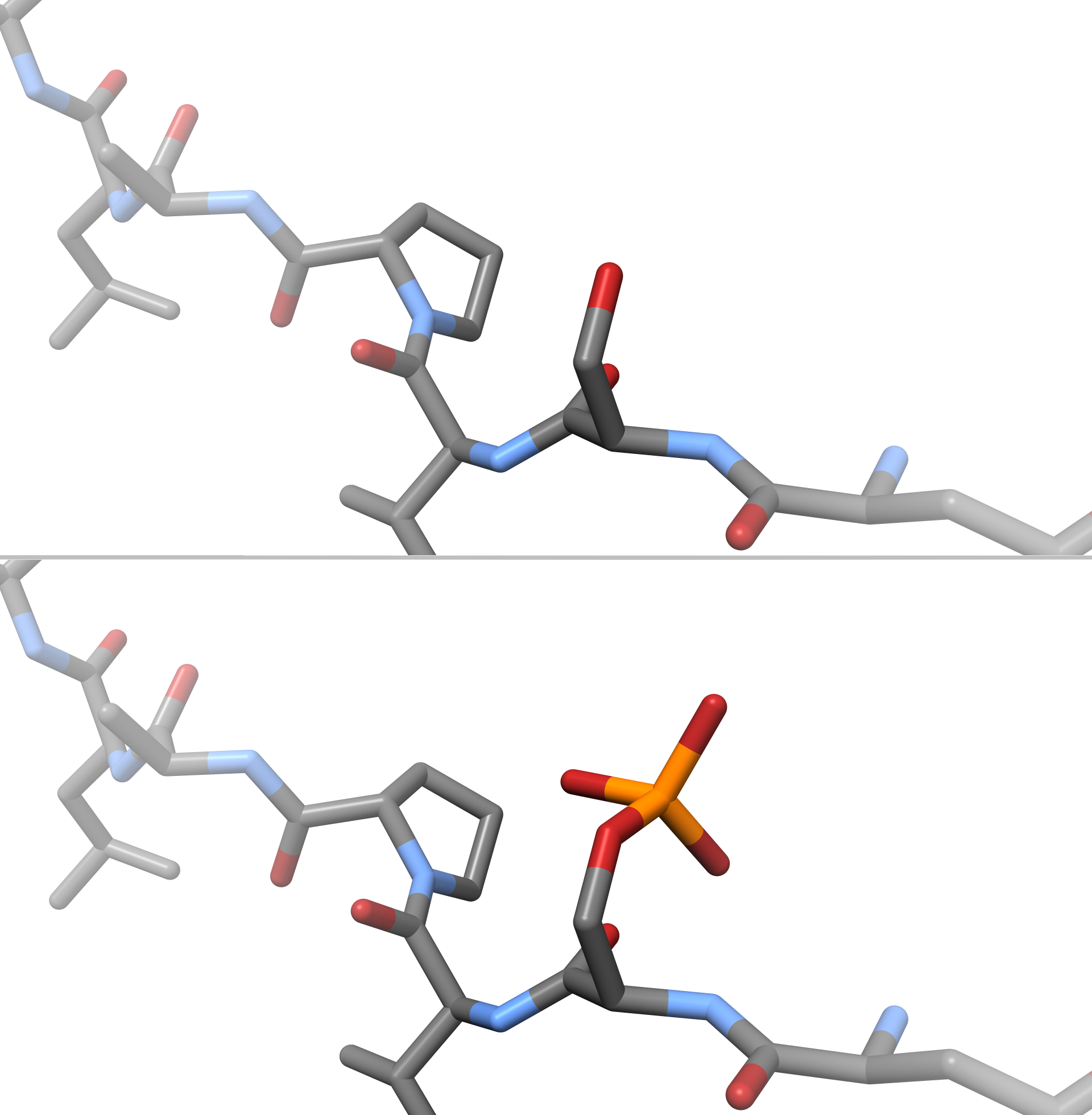|
Slit-Robo
Slit-Robo is the name of a cell signaling protein complex with many diverse functions including axon guidance and angiogenesis. Slit refers to a secreted protein that is most widely known as a repulsive axon guidance cue, and Robo refers to its transmembrane protein receptor. There are four different Robos and three Slits in vertebrates: Robo1, Robo2, Robo3/Rig-1, and Robo4, and Slit1, Slit2, Slit3. There are three Robos and a single Slit in ''Drosophila''. The corresponding Slit and Robo homologues in ''C. elegans'' are Slt and Sax-3, respectively. Slits are characterized by four distinct domains, each containing variable numbers of leucine-rich repeats (LRRs), seven to nine EGF repeats, an ALPS domain (Agrin, Perlecan, Laminin, Slit), and a cysteine knot. Robos are characterized by five Ig-like domains, three fibronectin type III (FNIII) repeats, a transmembrane portion, and an intracellular tail with up to four conserved cytoplasmic motifs: CC0 (a potential site of ... [...More Info...] [...Related Items...] OR: [Wikipedia] [Google] [Baidu] |
Deleted In Colorectal Cancer
Netrin receptor DCC, also known as DCC, or colorectal cancer suppressor is a protein which in humans is encoded by the ''DCC'' gene. DCC has long been implicated in colorectal cancer and its previous name was ''Deleted in colorectal carcinoma''. Netrin receptor DCC is a single transmembrane receptor. Since it was first discovered in a colorectal cancer study in 1990, ''DCC'' has been the focus of a significant amount of research. ''DCC'' held a controversial place as a tumour suppressor gene for many years, and is well known as an axon guidance receptor that responds to netrin-1. More recently DCC has been characterized as a #DCC as a dependence receptor, dependence receptor, and many hypotheses have been put forward that have revived interest in ''DCCs candidacy as a tumour suppressor gene, as it may be a ligand-dependent suppressor that is frequently epigenetically silenced. Background Early studies of colorectal tumours found that allelic deletions of segments of chromosome ... [...More Info...] [...Related Items...] OR: [Wikipedia] [Google] [Baidu] |
Cell Signaling
In biology, cell signaling (cell signalling in British English) or cell communication is the ability of a cell to receive, process, and transmit signals with its environment and with itself. Cell signaling is a fundamental property of all cellular life in prokaryotes and eukaryotes. Signals that originate from outside a cell (or extracellular signals) can be physical agents like mechanical pressure, voltage, temperature, light, or chemical signals (e.g., small molecules, peptides, or gas). Cell signaling can occur over short or long distances, and as a result can be classified as autocrine, juxtacrine, intracrine, paracrine, or endocrine. Signaling molecules can be synthesized from various biosynthetic pathways and released through passive or active transports, or even from cell damage. Receptors play a key role in cell signaling as they are able to detect chemical signals or physical stimuli. Receptors are generally proteins located on the cell surface or within th ... [...More Info...] [...Related Items...] OR: [Wikipedia] [Google] [Baidu] |
EGF-like Domain
The EGF-like domain is an evolutionary conserved protein domain, which derives its name from the epidermal growth factor where it was first described. It comprises about 30 to 40 amino-acid residues and has been found in a large number of mostly animal proteins. Most occurrences of the EGF-like domain are found in the extracellular domain of membrane-bound proteins or in proteins known to be secreted. An exception to this is the prostaglandin-endoperoxide synthase. The EGF-like domain includes 6 cysteine residues which in the epidermal growth factor have been shown to form 3 disulfide bonds. The structures of 4-disulfide EGF-domains have been solved from the laminin and integrin proteins. The main structure of EGF-like domains is a two-stranded β-sheet followed by a loop to a short C-terminal, two-stranded β-sheet. These two β-sheets are usually denoted as the major (N-terminal) and minor (C-terminal) sheets. EGF-like domains frequently occur in numerous tandem copies in pr ... [...More Info...] [...Related Items...] OR: [Wikipedia] [Google] [Baidu] |
Ena (gene)
Ena or ENA may refer to: Education * École nationale d'administration, French Grande école, for civil service * Education Networks of America, Internet service provider Fictional characters * Ena Sharples, from the British soap opera ''Coronation Street'' * Ena Shinonome, from the Japanese video game '' Hatsune Miku: Colorful Stage!'' * Aunt Ena, from the book '' Bambi, a Life in the Woods'' * ENA, main character of the animation series of the same name Government and politics * English National Association, a former political party * Ensame Nacionalista Astur, a defunct political party in Spain * Ethiopian News Agency, of the Government of Ethiopia * '' Étoile Nord-Africaine'' (The North African Star), a former Algerian nationalist organization People Given name or nickname * Ena von Baer (born 1974), Chilean journalist, political scientist and senator * Ena Baga (1906–2004), British pianist and theatre organist * Ena Begović (1960–2000), Croatian actress * ... [...More Info...] [...Related Items...] OR: [Wikipedia] [Google] [Baidu] |
Abl Gene
Tyrosine-protein kinase ABL1 also known as ABL1 is a protein that, in humans, is encoded by the ''ABL1'' gene (previous symbol ''ABL'') located on chromosome 9. c-Abl is sometimes used to refer to the version of the gene found within the mammalian genome, while v-Abl refers to the viral gene, which was initially isolated from the Abelson murine leukemia virus. Function The ''ABL1'' proto-oncogene encodes a cytoplasmic and nuclear protein tyrosine kinase that has been implicated in processes of cell differentiation, cell division, cell adhesion, and stress response such as DNA repair. Activity of ABL1 protein is negatively regulated by its SH3 domain, and deletion of the SH3 domain turns ABL1 into an oncogene. The t(9;22) translocation results in the head-to-tail fusion of the '' BCR'' and ''ABL1'' genes, leading to a fusion gene present in many cases of chronic myelogenous leukemia. The DNA-binding activity of the ubiquitously expressed ABL1 tyrosine kinase is regulated b ... [...More Info...] [...Related Items...] OR: [Wikipedia] [Google] [Baidu] |
Co-receptor
A co-receptor is a cell surface receptor that binds a signalling molecule in addition to a primary receptor in order to facilitate ligand recognition and initiate biological processes, such as entry of a pathogen into a host cell. Properties The term co-receptor is prominent in literature regarding signal transduction, the process by which external stimuli regulate internal cellular functioning.Gomperts, BD.; Kramer, IM. Tatham, PER. (2002). Signal transduction. Academic Press. ISBN. The key to optimal cellular functioning is maintained by possessing specific machinery that can carry out tasks efficiently and effectively. Specifically, the process through which intermolecular reactions forward and amplify extracellular signals across the cell surface has developed to occur by two mechanisms. First, cell surface receptors can directly transduce signals by possessing both serine and threonine or simply serine in the cytoplasmic domain. They can also transmit signals through adaptor m ... [...More Info...] [...Related Items...] OR: [Wikipedia] [Google] [Baidu] |
Ena/Vasp Homology Proteins
ENA/VASP homology proteins or EVH proteins are a family of closely related proteins involved in cell motility in vertebrate and invertebrate animals. EVH proteins are modular proteins that are involved in actin polymerization, as well as interactions with other proteins. Within the cell, Ena/VASP proteins are found at the leading edge of Lamellipodia and at the tips of filopodia. Ena, the founding member of the family was discovered in a drosophila genetic screen for mutations that act as dominant suppressors of the abl non receptor tyrosine kinase. Invertebrate animals have one Ena homologue, whereas mammals have three, named Mena, VASP, and Evl. Ena/VASP proteins promote the spatially regulated actin polymerization required for efficient chemotaxis in response to attractive and repulsive guidance cues. Mice lacking functional copies of all three family members display pleiotropic phenotypes including exencephaly, edema, failures in neurite formation, and embryonic lethality ... [...More Info...] [...Related Items...] OR: [Wikipedia] [Google] [Baidu] |
Netrin
Netrins are a class of proteins involved in axon guidance. They are named after the Sanskrit word "netr", which means "one who guides". Netrins are genetically conserved across nematode worms, fruit flies, frogs, mice, and humans. Structurally, netrin resembles the extracellular matrix protein laminin. Netrins are chemotropic; a growing axon will either move towards or away from a higher concentration of netrin. Though the detailed mechanism of axon guidance is not fully understood, it is known that netrin attraction is mediated through UNC-40/DCC cell surface receptors and repulsion is mediated through UNC-5 receptors. Netrins also act as growth factors, encouraging cell growth activities in target cells. Mice deficient in netrin fail to form the hippocampal comissure or the corpus callosum. A proposed model for netrin activity in the spinal column of developing human embryos is that netrins are released by the floor plate and then are picked up by receptor protei ... [...More Info...] [...Related Items...] OR: [Wikipedia] [Google] [Baidu] |
Phosphorylation
In chemistry, phosphorylation is the attachment of a phosphate group to a molecule or an ion. This process and its inverse, dephosphorylation, are common in biology and could be driven by natural selection. Text was copied from this source, which is available under a Creative Commons Attribution 4.0 International License. Protein phosphorylation often activates (or deactivates) many enzymes. Glucose Phosphorylation of sugars is often the first stage in their catabolism. Phosphorylation allows cells to accumulate sugars because the phosphate group prevents the molecules from diffusing back across their transporter. Phosphorylation of glucose is a key reaction in sugar metabolism. The chemical equation for the conversion of D-glucose to D-glucose-6-phosphate in the first step of glycolysis is given by :D-glucose + ATP → D-glucose-6-phosphate + ADP :ΔG° = −16.7 kJ/mol (° indicates measurement at standard condition) Hepatic cells are freely permeable to glucose, an ... [...More Info...] [...Related Items...] OR: [Wikipedia] [Google] [Baidu] |
Tyrosine
-Tyrosine or tyrosine (symbol Tyr or Y) or 4-hydroxyphenylalanine is one of the 20 standard amino acids that are used by cells to synthesize proteins. It is a non-essential amino acid with a polar side group. The word "tyrosine" is from the Greek ''tyrós'', meaning ''cheese'', as it was first discovered in 1846 by German chemist Justus von Liebig in the protein casein from cheese. It is called tyrosyl when referred to as a functional group or side chain. While tyrosine is generally classified as a hydrophobic amino acid, it is more hydrophilic than phenylalanine. It is encoded by the codons UAC and UAU in messenger RNA. Functions Aside from being a proteinogenic amino acid, tyrosine has a special role by virtue of the phenol functionality. It occurs in proteins that are part of signal transduction processes and functions as a receiver of phosphate groups that are transferred by way of protein kinases. Phosphorylation of the hydroxyl group can change the activity of the targ ... [...More Info...] [...Related Items...] OR: [Wikipedia] [Google] [Baidu] |
Fibronectin Type III Domain
The Fibronectin type III domain is an evolutionarily conserved protein domain that is widely found in animal proteins. The fibronectin protein in which this domain was first identified contains 16 copies of this domain. The domain is about 100 amino acids long and possesses a beta sandwich structure. Of the three fibronectin-type domains, type III is the only one without disulfide bonding present. Fibronectin domains are found in a wide variety of extracellular proteins. They are widely distributed in animal species, but also found sporadically in yeast, plant and bacterial proteins. Human proteins containing this domain ABI3BP; ANKFN1; ASTN2; AXL; BOC; BZRAP1; C20orf75; CDON; CHL1; CMYA5; CNTFR; CNTN1; CNTN2; CNTN3; CNTN4; CNTN5; CNTN6; COL12A1; COL14A1; COL20A1; COL7A1; CRLF1; CRLF3; CSF2RB; CSF3R; DCC; DSCAM; DSCAML1; EBI3; EGFLAM; EPHA1; EPHA10; EPHA2; ... [...More Info...] [...Related Items...] OR: [Wikipedia] [Google] [Baidu] |




